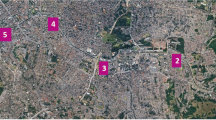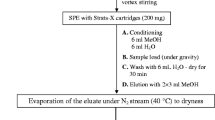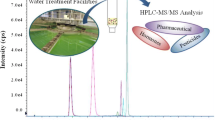Abstract
A fast and sensitive method for the determination of a structurally and physico-chemically diverse group of contaminants of emerging concern (CEC) based on large-volume direct injection liquid chromatography-tandem mass spectrometry was developed. The method can be used to determine 20 CECs belonging to different pollutant families (pharmaceuticals, personal care products, and pesticides) in river water at nanogram per liter. A single analytical run is required and the positive and negative ionization modes can be used simultaneously. Because of the large-volume injections of samples and the high sensitivity of the current mass spectrometers, the method has no need of a preconcentration step. The analytes are quantitated with matrix-matched calibration curves. The estimated limits of detection were in the range 0.1–5 ng L−1. The accuracy of the method was in the range 86–114%, and the precision, expressed as a relative standard deviation (RSD %), was below 18% for all the analytes (n = 5, at 5, 10, and 25 ng L−1). The method was applied to water samples taken from different points along the lower course of the Ebro River, Spain. A total of 12 out of the 20 target analytes were detected, and the ones at higher concentrations were caffeine and the pharmaceuticals paracetamol and ibuprofen (184.8 ng L−1, 63.3 ng L−1, and 23.3 ng L−1, respectively).

Similar content being viewed by others
References
Benson R, Conerly OD, Sander W, Batt AL, Boone JS, Furlong ET, et al. Human health screening and public health significance of contaminants of emerging concern detected in public water supplies. Sci Total Environ. 2017;579:1643–8.
Directive 2013/39/EU of the European Parliament and of the Council of 12 August 2013 amending Directives 2000/60/EC and 2008/105/EC as regards priority substances in the field of water policy, Off. J. Eur. Commun. L226/1 (2013) 1-17.
Decision 2015/495 establishing a watch list of substances for Union-wide monitoring in the field of water policy pursuant to Directive 2008/105/EC of the European Parliament and of the Council, Off. J. Eur. Commun. L78/40 (2015) 40-42.
2018/840, Commission Implementing Decision (EU) 2018/840 establishing a watch list of substances for Union-wide monitoring in the field of water policy pursuant to Directive 2008/105/EC of the European Parliament and of the Council and repealing Comission Implementing Decision (EU) 2015/495, Off. J. Eur. Commun. L141/9 (2018) 9-12.
Richardson SD, Kimura SY. Water analysis: emerging contaminants and current issues. Anal Chem. 2016;88(1):546–82.
Pedrouzo M, Borrull F, Pocurull E, Marcé RM. Presence of pharmaceuticals and hormones in waters from sewage treatment plants. Water Air Soil Pollut. 2011;217:267–81.
Tijani J, Fatoba O, Petrik LF. A review of pharmaceuticals and endocrine-disrupting compounds: sources, effects, removal, and detections. Water Air Soil Pollut. 2013;224:1770–99.
Gurke R, Rößler M, Marx C, Diamond S, Schubert S, Oertel R, et al. Occurrence and removal of frequently prescribed pharmaceuticals and corresponding metabolites in wastewater of a sewage treatment plant. Sci Total Environ. 2015;532:762–70.
Barbosa MO, Moreira NFF, Ribeiro AR, Pereira MFR, Silva AMT. Occurrence and removal of organic micropollutants: an overview of the watch list of EU Decision 2015/495. Water Res. 2016;94:257–79.
Gray JL, Borch T, Furlong ET, Davis JG, Yager TJ, Yang YY, et al. Rainfall-runoff of anthropogenic waste indicators from agricultural fields applied with municipal biosolids. Sci Total Environ. 2017;580:83–9.
Padhye LP, Yao H, Kung’u FT, Huang CH. Year-long evaluation on the occurrence and fate of pharmaceuticals, personal care products, and endocrine disrupting chemicals in an urban drinking water treatment plant. Water Res. 2014;51:266–76.
Meffe R, Bustamante I. Emerging organic contaminants in surface water and groundwater: a first overview of the situation in Italy. Sci Total Environ. 2014;481:280–95.
Boleda MR, Alechaga É, Moyano E, Galceran MT, Ventura F. Survey of the occurrence of pharmaceuticals in Spanish finished drinking waters. Environ Sci Pollut Res. 2014;21:10917–39.
Gaffney VJ, Almeida CMM, Rodrigues A, Ferreira E, Benoliel MJ, Cardoso VV. Occurrence of pharmaceuticals in a water supply system and related human risk assesment. Water Res. 2015;72:199–208.
Madikizela LM, Tavengwa NT, Chimuka L. Status of pharmaceuticals in African water bodies: occurrence, removal an analytical methods. J Environ Manag. 2017;193:211–20.
Wilkinson J, Hooda PS, Barker J, Barton S, Swinden J. Occurrence, fate and transformation of emerging contaminants in water: an overarching review of the field. Environ Pollut. 2017;231:954–70.
Sousa JCG, Ribeiro AR, Barbosa MO, Pereira MFR, Silva AMT. A review on environmental monitoring of water organic pollutants identified by EU guidelines. J Hazard Mater. 2018;344:146–62.
Pal A, He Y, Jekel M, Reinhard M, Gin KYH. Emerging contaminants of public health significance as water quality indicator compunds in the urban water cycle. Environ Int. 2014;71:46–62.
Gavrilescu M, Demnerová K, Aamand J, Agathos S, Favio F. Emerging contaminants in the environment: present and future challenges in biomonitoring, ecological risks and bioremediation. New Biotech. 2015;32:147–56.
Tijani JO, Fatoba OO, Babajide OO, Petrik LF. Pharmaceuticals, endocrine disruptors, personal care products, nanomaterials and perfluorinated pollutants: a review. Environ Chem Lett. 2016;14:27–49.
Rodil R, Quintana JB, López-Mahía P, Muniategui-Lorenzo S, Prada-Rodríguez D. Multi-residue analytical method for the determination of emerging pollutants in water by solid-phase extraction and liquid chromatography–tandem mass spectrometry. J Chromatogr A. 2009;1216:2958–69.
Robles-Molina J, Lara-Ortega FJ, Gilbert-López B, García-Reyes JF, Molina-Díaz A. Multi-residue method for the determination of over 400 priority and emerging pollutants in water and wastewater by solid-phase extraction and liquid chromatography-time-of-flight massspectrometry. J Chromatogr A. 2014;1350:30–43.
Gago-Ferrero P, Mastroianni N, Díaz-Cruz MS, Barceló D. Fully automated determination of nine ultraviolet filters and transformation products in natural waters and wastewaters by on-line solid phase extraction-liquid chromatography-tandem mass spectrometry. J Chromatogr A. 2013;1294:106–16.
López-Serna R, Pérez S, Ginebreda A, Petrović M, Barceló D. Fully automated determination of 74 pharmaceuticals in environmental and waste waters by online solid phase extraction–liquid chromatography-electrospray–tandem mass spectrometry. Talanta. 2010;83:410–24.
Rubirola A, Boleda MR, Galceran MT. Multiresidue analysis of 24 Water Framework Directive priority substances by on-line solid phase extraction-liquid chromatography tandem mass spectrometry in environmental waters. J Chromatogr A. 2017;1493:64–75.
Gusmaroli L, Insa S, Petrovic M. Development of an online SPE-UHPLC-MS/MS method for the multiresidue analysis of the 17 compounds from the EU “Watch list”. Anal Bioanal Chem. 2018;410:4165–76.
Čelić M, Insa S, Škrbić B, Petrović M. Development of a sensitive and robust online dual column liquid chromatography-tandem mass spectrometry method for the analysis of natural and synthetic estrogens and their conjugates in river water and wastewater. Anal Bioanal Chem. 2017;409:5427–40.
Berset JD, Brenneisen R, Mathieu C. Analysis of llicit and illicit drugs in waste, surface and lake water samples using large volume direct injection high performance liquid chromatography – electrospray tandem mass spectrometry (HPLC–MS/MS). Chemosphere. 2010;81:859–66.
Díaz L, Llorca-Pórcel J, Valor I. Ultra trace determination of 31 pesticides in water samples by direct injection–rapid resolution liquid chromatography-electrospray tandem mass spectrometry. Anal Chim Acta. 2008;624:90–6.
Greulich K, Alder L. Fast multiresidue screening of 300 pesticides in water for human consumption by LC-MS/MS. Anal Bioanal Chem. 2008;391:183–97.
Reemtsma T, Alder L, Banasiak U. A multimethod for the determination of 150 pesticide metabolites in surface water and groundwater using direct injection liquid chromatography–mass spectrometry. J Chromatogr A. 2013;1271:95–104.
Boix C, Ibáñez M, Sancho JV, Rambla J, Aranda JL, Ballester S, et al. Fast determination of 40 drugs in water using large volume direct injection liquid chromatography–tandem mass spectrometry. Talanta. 2015;131:719–27.
Panditi VR, Batchu SR, Gardinali PR. Online solid-phase extraction-liquid chromatography electrospray-tandem mass spectrometry determination of multiple classes of antibiotics in environmental and treated waters. Anal Bioanal Chem. 2013;405:5953–64.
Rossman J, Schubert S, Gurke R, Oertel R, Kirch W. Simultaneous determination of most prescribed antibiotics in multiple urban wastewater by SPE-LC-MS/MS. J Chromatogr B. 2014;969:162–70.
Bayen S, Yi X, Segovia E, Zhou Z, Kelly BC. Analysis of selected antibiotics in surface freshwater and seawater using direct injection in liquid chromatography electrosparay ionization tandem mass spectrometry. J Chromatogr A. 2014;1338:38–43.
Senta I, Krizman-Matasic I, Terzic S, Ahel M. Comprehensive determination of macrolide antibiotics, their syntesis intermediates in transformation products in wastewater effluents and ambient waters by liquid chromatography-tandem mass spectrometry. J Chromatogr A. 2017;1509:60–8.
Pedrouzo M, Borrull F, Marcé RM, Pocurull E. Ultra-high performance liquid-chromatography-tandem mass spectrometry for determining the presence of eleven personal care products in surface and wastewaters. J Chromatogr A. 2009;1216:6994–7000.
Martínez Bueno MJ, Uclés S, Hernando MD, Fernández-Alba AR. Development of a solvent-free method for the simultaneous idientification/quantification of drugs of abuse and their metabolites in environmental water by LC-MS/MS. Talanta. 2011;85:157–66.
Dasenaki ME, Thomaidis NS. Multianalyte method for the determination of pharmaceuticals in wastewater samples using solid-phase extraction and liquid chromatography–tandem mass spectrometry. Anal Bioanal Chem. 2015;407:4229–45.
Buerge IJ, Poiger T, Müller MD, Buser HR. Caffeine, an anthropogenic marker, for wastewater contamination of surface waters. Environ Sci Technol. 2003;37:691–700.
Buerge IJ, Poiger T, Müller MD, Buser HR. Combined sewer overflows to surface waters detected by the anthropogenic marker caffeine. Environ Sci Technol. 2006;40:4096–102.
Decision 2002/657/EC implementing Council Directive 96/25/EC concerning the performance of analytical methods and the interpretation of results, Off. J. Eur. Commun. L221/8 (2002) 8-36.
González-Mariño I, Quintana JB, Rodríguez I, Cela R. Simultaneous determination of parabens, triclosan and triclocarban in water by liquid chromatography/electrospray ionisation tandem mass spectrometry. Rapid Commun Mass Spectrom. 2009;23:1756–66.
Negreira N, Rodríguez I, Ramil M, Rubí E, Cela R. Solid-phase extraction followed by liquid chromatography-tandem mass spectrometry for the determination of hydroxylated benzophenone UV absorbers in environmental water samples. Anal Chem Acta. 2009;654:162–70.
Kruve A, Kaupmees K. Adduct formation in ESI/MS by mobile phase additives. J Am Soc Mass Spectrom. 2017;28:887–94.
Busetti F, Backe WJ, Bendixen N, Maier U, Place B, Giger W, et al. Trace analysis of environmental matrices by large-volume injection and liquid chromatography-mass spectrometry. Anal Bioanal Chem. 2012;402:175–86.
Meierjohann A, Kortesmäki E, Brozinski JM, Kronberg L. An online SPE LC-MS/MS method for the analysis of antibiotics in environmental waters. Environ Sci Pollut Res. 2017;24:8692–9.
Chiaia AC, Banta-Green C, Field J. Eliminating solid phase extraction with large-volume injection LC/MS/MS: analysis of illicit drugs legal drugs and human urine indicators in US wastewaters. Envrion Sci Technol. 2008;42:8841–8.
Niessen WMA, Manini P, Andreoli R. Matrix effects in quantitative pesticide analysis using liquid chromatography–mass spectrometry. Mass Spect Rev. 2006;25:881–99.
Zhou JL, Kang Y. Matrix effect in high-performance liquid chromatography-tandem mass spectrometry analysis of antibiotics in environmental water samples. J Sep Sci. 2013;36:564–71.
Valcárcel Y, Alonso SG, Rodríguez-Gil JL, Castaño A, Montero JC, Criado-Alvarez JJ, et al. Seasonal variation of pharmaceutically active compounds in surface (Tagus River) and tap water (Central Spain). Environ Sci Pollut Res. 2013;20:1396–412.
Moreno-González R, Rodríguez-Mozaz S, Gros M, Pérez-Cánovas E, Barceló D, León VM. Input of pharmaceuticals through coastal surface watercourses into a Mediterranean lagoon (Mar Menor, SE Spain): sources and seasonal variations. Sci Total Environ. 2014;490:59–72.
Da Silva BF, Jelic A, López-Serna R, Mozeto AA, Petrović M, Barceló D. Occurrence and distribuition of pharmaceuticals in surface water, suspended solids and sediments of the Ebro river basin, Spain. Chemosphere. 2011;85:1331–9.
Gros M, Petrović M, Barceló D. Wastewater treatment plants as a pathway for aquatic contamination by pharmaceuticals in the Ebro River Basin (Northeast Spain). Environ Chem. 2007;26:1553–62.
López-Serna R, Petrović M, Barceló D. Occurrence and distribuiton of multi-class pharmaceuticals and their active metabolites and transformation products in the Ebro River basin (NE Spain). Sci Total Environ. 2012;440:280–9.
Ccanccapa A, Masiá A, Navarro-Ortega A, Picó Y, Barceló D. Pesticides in the Ebro River basin: occurrence and risk assessment. Environ Pollut. 2016;211:414–24.
Decision 2016/110 not approving triclosan as an existing active substance for use in biocidal products for product type 1, Off. J. Eur. Commun. L21/86 (2016).
Acknowledgments
The authors also thank the support of Pla de Doctorats Industrials (DI) of the University and Research Secretary of the Economy and Knowledge Department of the Generalitat de Catalunya.
Funding
The research leading to these results has received funding from the Ministerio de Economía, Industria y Competitividad; the Agencia Estatal de Investigación (AEI); and the European Regional Development Fund (ERDF) (CTQ2017-84373-R).
Author information
Authors and Affiliations
Corresponding author
Ethics declarations
Conflict of interest
The authors declare that they have no conflict of interest.
Additional information
Publisher’s note
Springer Nature remains neutral with regard to jurisdictional claims in published maps and institutional affiliations.
Rights and permissions
About this article
Cite this article
Borrull, J., Colom, A., Fabregas, J. et al. A simple, fast method for the analysis of 20 contaminants of emerging concern in river water using large-volume direct injection liquid chromatography-tandem mass spectrometry. Anal Bioanal Chem 411, 1601–1610 (2019). https://doi.org/10.1007/s00216-019-01602-x
Received:
Revised:
Accepted:
Published:
Issue Date:
DOI: https://doi.org/10.1007/s00216-019-01602-x




